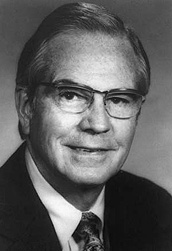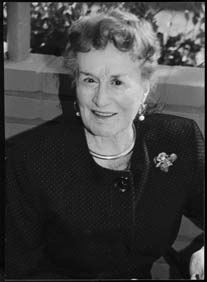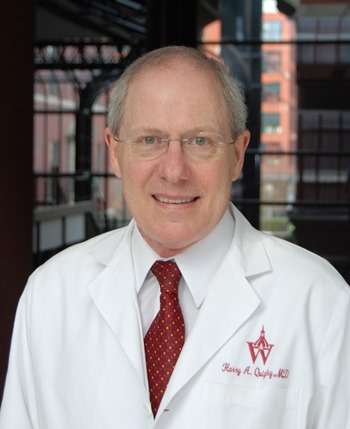 A. EDWARD MAUMENEE, an international leader in the prevention and cure of blindness, for many years headed the Wilmer Eye Institute and was the William Holland Wilmer Professor of Ophthalmology. He received scores of professional awards, including the 1970 Lucian Howe Gold Medal from the American Medical Association. Dr. Maumenee died in 1997.
A. EDWARD MAUMENEE, an international leader in the prevention and cure of blindness, for many years headed the Wilmer Eye Institute and was the William Holland Wilmer Professor of Ophthalmology. He received scores of professional awards, including the 1970 Lucian Howe Gold Medal from the American Medical Association. Dr. Maumenee died in 1997.
 MARGARET C. MOSHER, who died in 2002, was a businesswoman and philanthropist from Santa Barbara, California. She was a member of the Wilmer Eye Institute Advisory Council with many ties to the institute. In addition to the establishment of the Margaret C. Mosher Professorship in Ophthalmology by her estate in 2002, she also provided generous support for the A. Edward Maumenee Professorship and a chair honoring Hopkins ophthalmologist Walter J. Stark for his corneal research. In 1998, she created the Walter J. Stark Corneal Research Fund. Her estate initiated the Walter J. Stark, M.D. and Margaret C. Mosher Center for Cataract and Corneal Diseases. The widow of Samuel B. Mosher, founder of Signal Oil and Gas Company (later AlliedSignal, Inc.), Mrs. Mosher served on the board of the Signal Companies and was president of the Samuel B. Mosher Foundation.
MARGARET C. MOSHER, who died in 2002, was a businesswoman and philanthropist from Santa Barbara, California. She was a member of the Wilmer Eye Institute Advisory Council with many ties to the institute. In addition to the establishment of the Margaret C. Mosher Professorship in Ophthalmology by her estate in 2002, she also provided generous support for the A. Edward Maumenee Professorship and a chair honoring Hopkins ophthalmologist Walter J. Stark for his corneal research. In 1998, she created the Walter J. Stark Corneal Research Fund. Her estate initiated the Walter J. Stark, M.D. and Margaret C. Mosher Center for Cataract and Corneal Diseases. The widow of Samuel B. Mosher, founder of Signal Oil and Gas Company (later AlliedSignal, Inc.), Mrs. Mosher served on the board of the Signal Companies and was president of the Samuel B. Mosher Foundation.
Held by Harry A. Quigley

Dr. HARRY A. QUIGLEY is the A. Edward Maumenee Professor of Ophthalmology and the director of the Glaucoma Center of Excellence at the Wilmer Eye Institute. He was a founding member of the American Glaucoma Society, serving for eight years as its Secretary, and was elected to five-year terms as chief executive officer of the Association for Research in Vision and Ophthalmology (ARVO) and as editor-in-chief of Investigative Ophthalmology and Visual Science.
He has published over 350 peer-reviewed articles and his reports are the most cited in the ophthalmic literature over the last 30 years (Archives of Ophthalmology, 2007). His research has improved the early diagnosis of glaucoma and has developed instruments and techniques to identify glaucoma damage better. He has participated in pioneering studies of the epidemiology, morbidity, and progression rate of glaucoma and other eye disease in American, African, Asian, and Hispanic populations, serving as a consultant to the World Health Organization. In the laboratory, he has demonstrated successful gene therapy to protect retinal ganglion cells from experimental glaucoma and developed glaucoma models in monkeys, rats, and mice.
 A. EDWARD MAUMENEE, an international leader in the prevention and cure of blindness, for many years headed the Wilmer Eye Institute and was the William Holland Wilmer Professor of Ophthalmology. He received scores of professional awards, including the 1970 Lucian Howe Gold Medal from the American Medical Association. Dr. Maumenee died in 1997.
A. EDWARD MAUMENEE, an international leader in the prevention and cure of blindness, for many years headed the Wilmer Eye Institute and was the William Holland Wilmer Professor of Ophthalmology. He received scores of professional awards, including the 1970 Lucian Howe Gold Medal from the American Medical Association. Dr. Maumenee died in 1997. MARGARET C. MOSHER, who died in 2002, was a businesswoman and philanthropist from Santa Barbara, California. She was a member of the Wilmer Eye Institute Advisory Council with many ties to the institute. In addition to the establishment of the Margaret C. Mosher Professorship in Ophthalmology by her estate in 2002, she also provided generous support for the A. Edward Maumenee Professorship and a chair honoring Hopkins ophthalmologist Walter J. Stark for his corneal research. In 1998, she created the Walter J. Stark Corneal Research Fund. Her estate initiated the Walter J. Stark, M.D. and Margaret C. Mosher Center for Cataract and Corneal Diseases. The widow of Samuel B. Mosher, founder of Signal Oil and Gas Company (later AlliedSignal, Inc.), Mrs. Mosher served on the board of the Signal Companies and was president of the Samuel B. Mosher Foundation.
MARGARET C. MOSHER, who died in 2002, was a businesswoman and philanthropist from Santa Barbara, California. She was a member of the Wilmer Eye Institute Advisory Council with many ties to the institute. In addition to the establishment of the Margaret C. Mosher Professorship in Ophthalmology by her estate in 2002, she also provided generous support for the A. Edward Maumenee Professorship and a chair honoring Hopkins ophthalmologist Walter J. Stark for his corneal research. In 1998, she created the Walter J. Stark Corneal Research Fund. Her estate initiated the Walter J. Stark, M.D. and Margaret C. Mosher Center for Cataract and Corneal Diseases. The widow of Samuel B. Mosher, founder of Signal Oil and Gas Company (later AlliedSignal, Inc.), Mrs. Mosher served on the board of the Signal Companies and was president of the Samuel B. Mosher Foundation.